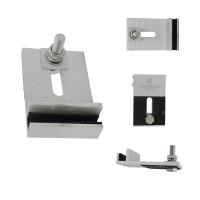30mm Thickness Terracotta Facade cladding Support System
A 30mm thickness terracotta facade cladding support system
typically involves a combination of structural components and
installation techniques to ensure the terracotta panels are
securely attached to the building while allowing for thermal
movement, drainage, and ventilation. Below is an overview of the
key elements and considerations for such a system:
1. Support System Components
The support system for terracotta facade cladding generally
includes:
A. Primary Structure
Vertical Mullions: Aluminum or steel vertical profiles attached to
the building's structural frame.
Horizontal Rails: Horizontal supports that connect to the vertical
mullions, forming a grid to hold the terracotta panels.
B. Secondary Structure
Brackets and Cleats: Adjustable brackets or cleats that connect the
terracotta panels to the horizontal rails.
Anchors: Stainless steel or aluminum anchors that secure the
terracotta panels to the support system.
C. Panel Fixing System
Mechanical Fixings: Bolts, screws, or clips that attach the
terracotta panels to the support system.
Adhesive Fixings: In some cases, adhesives may be used in
combination with mechanical fixings for added stability.
D. Insulation and Backing
Thermal Insulation: Insulation boards (e.g., mineral wool or rigid
foam) installed between the building structure and the cladding
system.
Weather Barrier: A waterproof membrane or vapor barrier to protect
the building from moisture ingress.
2. Design Considerations
A. Panel Dimensions and Weight
Terracotta panels with a 30mm thickness are relatively lightweight
compared to thicker options, but their weight must still be
accounted for in the structural design.
Panel sizes and shapes should be designed to minimize stress
concentrations and allow for easy installation.
B. Thermal Movement
Terracotta expands and contracts with temperature changes, so the
support system must accommodate this movement.Expansion joints and sliding fixings are often used to allow for
thermal movement without causing cracks or damage.
C. Drainage and Ventilation
The system should include drainage channels and ventilation gaps to
prevent water accumulation and allow airflow behind the cladding.
This helps to reduce moisture buildup and improve the longevity of
the facade.
D. Wind Load and Structural Stability
The support system must be designed to withstand wind loads,
seismic forces, and other environmental factors.
Engineering calculations should ensure the system meets local
building codes and standards.
E. Aesthetic Considerations
The spacing, alignment, and joint design of the terracotta panels
should be carefully planned to achieve the desired visual effect.
Custom colors, textures, and finishes can be applied to the
terracotta panels to meet architectural requirements.
3. Installation Process
Preparation: Inspect the building structure and ensure it is ready
for cladding installation.
Primary Structure Installation: Install vertical mullions and
horizontal rails according to the design specifications.
Insulation and Weather Barrier: Apply insulation and a
weather-resistant barrier to the building envelope.
Panel Fixing: Attach terracotta panels to the support system using
mechanical fixings or a combination of mechanical and adhesive
methods.
Joint Sealing: Seal joints between panels with appropriate sealants
to prevent water ingress.
Final Inspection: Check the alignment, stability, and overall
appearance of the cladding system.
4. Advantages of Terracotta Facade Cladding
Durability: Terracotta is resistant to weathering, UV radiation,
and corrosion.
Aesthetic Appeal: Offers a natural, timeless appearance with a wide
range of design options.
Sustainability: Terracotta is made from natural clay, making it an
eco-friendly material.
Thermal Performance: Provides excellent insulation properties when
combined with proper backing materials.
Technical Parameters:
| Technical Parameters | Values |
|---|
| Warranty | 10 Years |
| Surface Finish | Anodizing Oxidation Coating |
| Size | 3.8cm, 4cm, 5cm |
| Color | Natural |
| Maintenance | Low |
| Application | Curtain Wall Cladding |
| Durability | High |
| Installation | Easy |
| Material | Aluminum |
| Shape | As Picture |
| Connected Rail | Used for connecting ceramic panels |
| Ceramic Panel Fixing | Securely holds ceramic panels in place |
| Connected Rail Spacing | Customizable for different panel sizes |
| Panel Thickness | 3mm, 4mm |
| Panel Shape | Customizable according to design |











